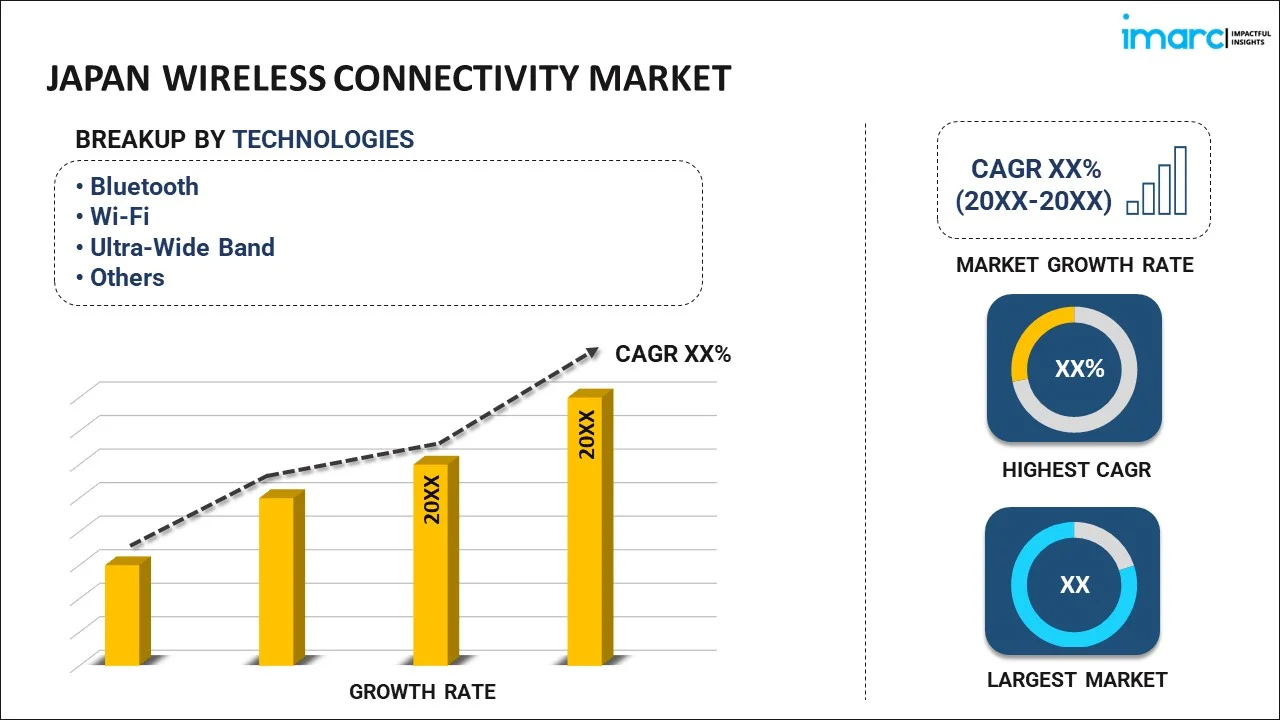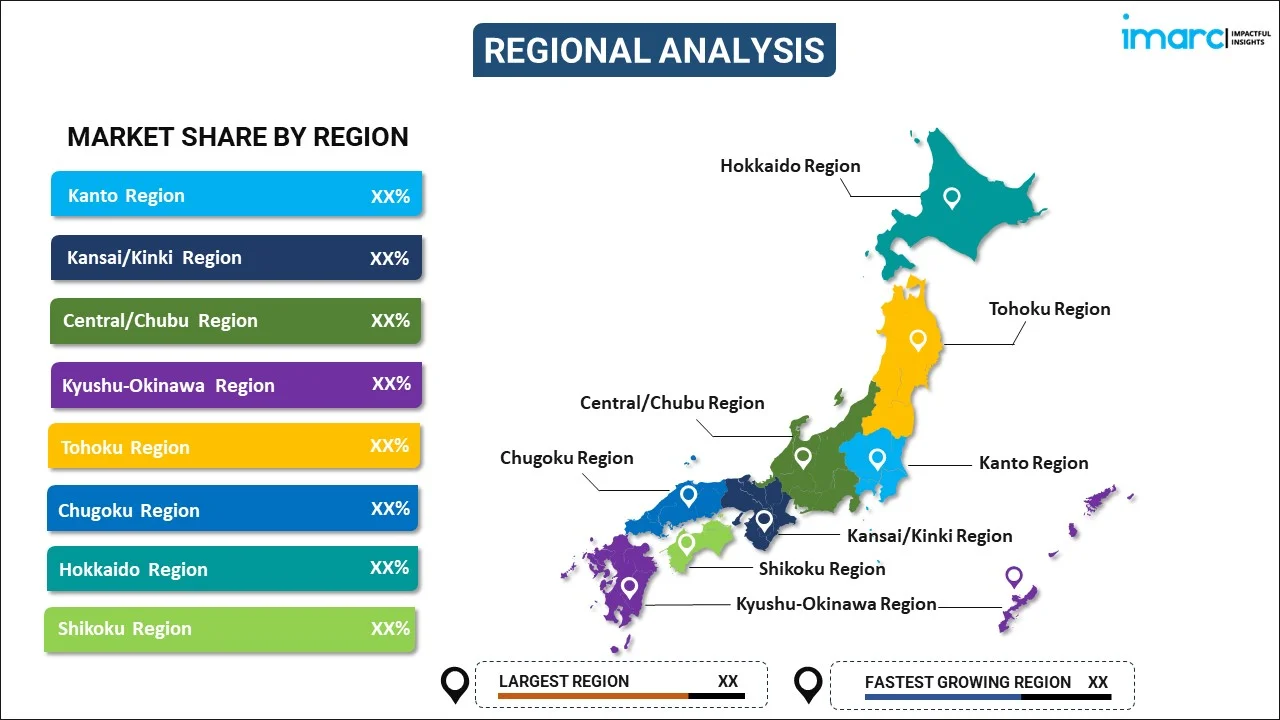
Japan Wireless Connectivity Market Report by Technology (Bluetooth, Wi-Fi, Ultra-Wide Band, NFC, Cellular, Zigbee, GPS, and Others), Network Type (Wireless Wide Area Network (WWAN), Wireless Personal Area Network (WPAN), Wireless Local Area Network (WLAN)), End User (Automotive and Transportation, Building Automation, Consumer Electronics and Wearables, Energy and Utilities, Healthcare, Industrial, IT and Telecom, and Others), and Region 2025-2033
Market Overview:
Japan wireless connectivity market size reached USD 6.3 Billion in 2024. Looking forward, IMARC Group expects the market to reach USD 12.1 Billion by 2033, exhibiting a growth rate (CAGR) of 7.3% during 2025-2033. The increasing demand for high-speed internet, IoT proliferation, 5G adoption, digital transformation, emerging remote work trends, favorable government initiatives, rising demand for connected vehicles and consumer electronics, and implementation of Industry 4.0 represent some of the key factors driving the market.
|
Report Attribute
|
Key Statistics
|
|---|---|
|
Base Year
|
2024 |
|
Forecast Years
|
2025-2033
|
|
Historical Years
|
2019-2024
|
| Market Size in 2024 | USD 6.3 Billion |
| Market Forecast in 2033 | USD 12.1 Billion |
| Market Growth Rate (2025-2033) | 7.3% |
Wireless connectivity refers to the capability of devices or systems to communicate and exchange data without the need for physical cables or wires. This technology enables seamless transmission of information through radio frequency signals, infrared waves, or other wireless methods. Common examples of wireless connectivity include Wi-Fi, Bluetooth, cellular networks, and satellite communication. Wi-Fi allows devices, such as smartphones, laptops, and smart home appliances to connect to the internet and communicate with each other within a specific range. Bluetooth facilitates short-range wireless data exchange between devices, making it suitable for applications like wireless headphones and file sharing. Cellular networks provide mobile devices with the ability to connect to the internet and make calls over long distances. Satellite communication extends connectivity globally, enabling data transmission across vast areas. The advent of wireless connectivity has transformed the way we communicate, work, and access information, fostering a more flexible and mobile society. It plays a crucial role in the development of smart cities, the Internet of Things (IoT), and other innovative technologies that rely on efficient and convenient data exchange without the constraints of physical connections.
Japan Wireless Connectivity Market Trends:
The Japan wireless connectivity market has witnessed robust growth driven by the escalating demand for high-speed and reliable internet connectivity across diverse sectors, including telecommunications, healthcare, and manufacturing. Besides this, the increasing proliferation of Internet of Things (IoT) devices, ranging from smart home appliances to industrial sensors, has amplified the need for efficient wireless communication, propelling the market growth. Furthermore, the surge in mobile device usage, particularly smartphones, and tablets, has driven the adoption of advanced wireless technologies such as fifth generation (5G), enhancing connectivity speeds and capabilities, creating a positive outlook for market expansion. In confluence with this, the rapid digital transformation across industries has spurred the deployment of wireless networks to facilitate seamless data exchange and real-time communication, strengthening the market growth. Additionally, the increasing trend of remote work and virtual collaboration, accentuated by the global pandemic, has necessitated robust wireless infrastructure, further fueling the market growth. In line with this, favorable government initiatives such as the development of smart cities combined with extensive investments in building a digitalized and connected ecosystem like digital healthcare systems and the integration of wireless technologies in public services are aiding in market expansion. Furthermore, the growing popularity of connected and autonomous vehicles has driven the demand for reliable wireless communication, enhancing vehicle-to-everything (V2X) connectivity, thereby strengthening the market growth. Apart from this, the rise in consumer electronics, such as smartwatches, fitness trackers, and smart home devices, has spurred the integration of wireless connectivity features, contributing to the market expansion.
Japan Wireless Connectivity Market Segmentation:
IMARC Group provides an analysis of the key trends in each segment of the market, along with forecasts at the country level for 2025-2033. Our report has categorized the market based on technology, network type, and end user.
Technology Insights:

- Bluetooth
- Wi-Fi
- Ultra-Wide Band
- NFC
- Cellular
- Zigbee
- GPS
- Others
The report has provided a detailed breakup and analysis of the market based on the technology. This includes bluetooth, wi-fi, ultra-wide band, NFC, cellular, zigbee, GPS, and others.
Network Type Insights:
- Wireless Wide Area Network (WWAN)
- Wireless Personal Area Network (WPAN)
- Wireless Local Area Network (WLAN)
A detailed breakup and analysis of the market based on the network type have also been provided in the report. This includes wireless wide area network (WWAN), wireless personal area network (WPAN), and wireless local area network (WLAN).
End User Insights:
- Automotive and Transportation
- Building Automation
- Consumer Electronics and Wearables
- Energy and Utilities
- Healthcare
- Industrial
- IT and Telecom
- Others
The report has provided a detailed breakup and analysis of the market based on the end user. This includes automotive and transportation, building automation, consumer electronics and wearables, energy and utilities, healthcare, industrial, IT and telecom, and others.
Regional Insights:

- Kanto Region
- Kansai/Kinki Region
- Central/ Chubu Region
- Kyushu-Okinawa Region
- Tohoku Region
- Chugoku Region
- Hokkaido Region
- Shikoku Region
The report has also provided a comprehensive analysis of all the major regional markets, which include Kanto Region, Kansai/Kinki Region, Central/ Chubu Region, Kyushu-Okinawa Region, Tohoku Region, Chugoku Region, Hokkaido Region, and Shikoku Region.
Competitive Landscape:
The market research report has also provided a comprehensive analysis of the competitive landscape. Competitive analysis such as market structure, key player positioning, top winning strategies, competitive dashboard, and company evaluation quadrant has been covered in the report. Also, detailed profiles of all major companies have been provided.
Japan Wireless Connectivity Market Report Coverage:
| Report Features | Details |
|---|---|
| Base Year of the Analysis | 2024 |
| Historical Period | 2019-2024 |
| Forecast Period | 2025-2033 |
| Units | Billion USD |
| Scope of the Report | Exploration of Historical Trends and Market Outlook, Industry Catalysts and Challenges, Segment-Wise Historical and Future Market Assessment:
|
| Technologies Covered | Bluetooth, Wi-Fi, Ultra-Wide Band, NFC, Cellular, Zigbee, GPS, Others |
| Network Types Covered | Wireless Wide Area Network (WWAN), Wireless Personal Area Network (WPAN), Wireless Local Area Network (WLAN) |
| End Users Covered | Automotive and Transportation, Building Automation, Consumer Electronics and Wearables, Energy and Utilities, Healthcare, Industrial, IT and Telecom, Others |
| Regions Covered | Kanto Region, Kansai/Kinki Region, Central/ Chubu Region, Kyushu-Okinawa Region, Tohoku Region, Chugoku Region, Hokkaido Region, Shikoku Region |
| Customization Scope | 10% Free Customization |
| Post-Sale Analyst Support | 10-12 Weeks |
| Delivery Format | PDF and Excel through Email (We can also provide the editable version of the report in PPT/Word format on special request) |
Key Questions Answered in This Report:
- How has the Japan wireless connectivity market performed so far and how will it perform in the coming years?
- What has been the impact of COVID-19 on the Japan wireless connectivity market?
- What is the breakup of the Japan wireless connectivity market on the basis of technology?
- What is the breakup of the Japan wireless connectivity market on the basis of network type?
- What is the breakup of the Japan wireless connectivity market on the basis of end user?
- What are the various stages in the value chain of the Japan wireless connectivity market?
- What are the key driving factors and challenges in the Japan wireless connectivity?
- What is the structure of the Japan wireless connectivity market and who are the key players?
- What is the degree of competition in the Japan wireless connectivity market?
Key Benefits for Stakeholders:
- IMARC’s industry report offers a comprehensive quantitative analysis of various market segments, historical and current market trends, market forecasts, and dynamics of the Japan wireless connectivity market from 2019-2033.
- The research report provides the latest information on the market drivers, challenges, and opportunities in the Japan wireless connectivity market.
- Porter's five forces analysis assist stakeholders in assessing the impact of new entrants, competitive rivalry, supplier power, buyer power, and the threat of substitution. It helps stakeholders to analyze the level of competition within the Japan wireless connectivity industry and its attractiveness.
- Competitive landscape allows stakeholders to understand their competitive environment and provides an insight into the current positions of key players in the market.
Need more help?
- Speak to our experienced analysts for insights on the current market scenarios.
- Include additional segments and countries to customize the report as per your requirement.
- Gain an unparalleled competitive advantage in your domain by understanding how to utilize the report and positively impacting your operations and revenue.
- For further assistance, please connect with our analysts.
 Inquire Before Buying
Inquire Before Buying
 Speak to an Analyst
Speak to an Analyst
 Request Brochure
Request Brochure
 Request Customization
Request Customization




.webp)




.webp)












